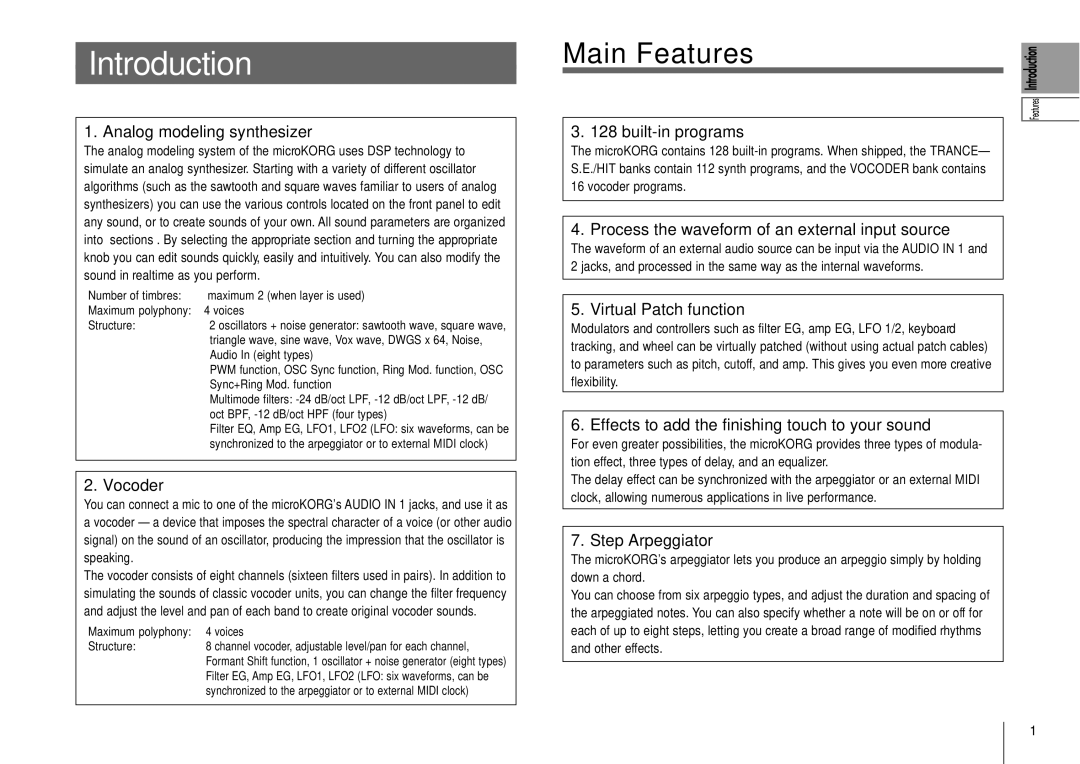
Introduction
1.Analog modeling synthesizer
The analog modeling system of the microKORG uses DSP technology to simulate an analog synthesizer. Starting with a variety of different oscillator algorithms (such as the sawtooth and square waves familiar to users of analog synthesizers) you can use the various controls located on the front panel to edit any sound, or to create sounds of your own. All sound parameters are organized into “sections”. By selecting the appropriate section and turning the appropriate knob you can edit sounds quickly, easily and intuitively. You can also modify the sound in realtime as you perform.
Number of timbres: | maximum 2 (when layer is used) |
Maximum polyphony: | 4 voices |
Structure: | 2 oscillators + noise generator: sawtooth wave, square wave, |
| triangle wave, sine wave, Vox wave, DWGS x 64, Noise, |
| Audio In (eight types) |
| PWM function, OSC Sync function, Ring Mod. function, OSC |
| Sync+Ring Mod. function |
| Multimode filters: |
| oct BPF, |
| Filter EQ, Amp EG, LFO1, LFO2 (LFO: six waveforms, can be |
| synchronized to the arpeggiator or to external MIDI clock) |
2.Vocoder
You can connect a mic to one of the microKORG's AUDIO IN 1 jacks, and use it as a vocoder – a device that imposes the spectral character of a voice (or other audio signal) on the sound of an oscillator, producing the impression that the oscillator is speaking.
The vocoder consists of eight channels (sixteen filters used in pairs). In addition to simulating the sounds of classic vocoder units, you can change the filter frequency and adjust the level and pan of each band to create original vocoder sounds.
Maximum polyphony: | 4 voices |
Structure: | 8 channel vocoder, adjustable level/pan for each channel, |
| Formant Shift function, 1 oscillator + noise generator (eight types) |
| Filter EG, Amp EG, LFO1, LFO2 (LFO: six waveforms, can be |
| synchronized to the arpeggiator or to external MIDI clock) |
Main Features
3.128 built-in programs
The microKORG contains 128
4.Process the waveform of an external input source
The waveform of an external audio source can be input via the AUDIO IN 1 and 2 jacks, and processed in the same way as the internal waveforms.
5.Virtual Patch function
Modulators and controllers such as filter EG, amp EG, LFO 1/2, keyboard tracking, and wheel can be virtually patched (without using actual patch cables) to parameters such as pitch, cutoff, and amp. This gives you even more creative flexibility.
6.Effects to add the finishing touch to your sound
For even greater possibilities, the microKORG provides three types of modula- tion effect, three types of delay, and an equalizer.
The delay effect can be synchronized with the arpeggiator or an external MIDI clock, allowing numerous applications in live performance.
7.Step Arpeggiator
The microKORG's arpeggiator lets you produce an arpeggio simply by holding down a chord.
You can choose from six arpeggio types, and adjust the duration and spacing of the arpeggiated notes. You can also specify whether a note will be on or off for each of up to eight steps, letting you create a broad range of modified rhythms and other effects.
1
